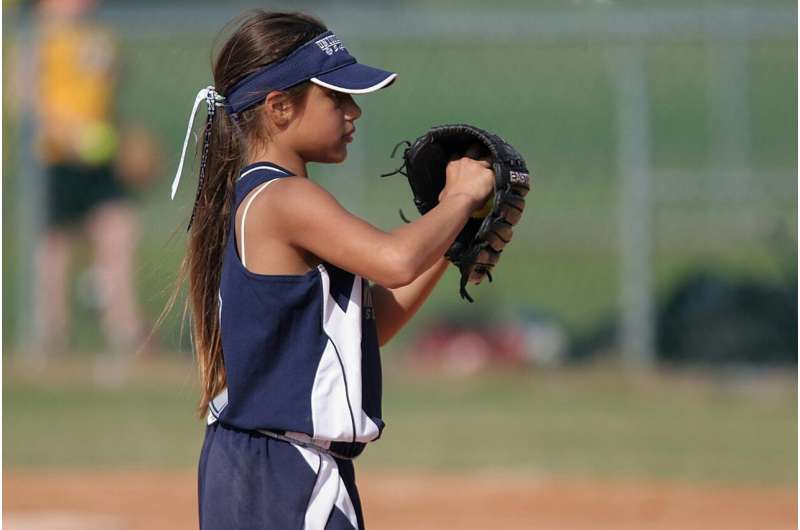
The 2024 Paris Olympics mark the first gender-equitable Olympic Games in history, with equal numbers of men and women athletes. Audiences today are being exposed to the phenomenal accomplishments of women athletes more than ever before.
This year also saw the launch of the Professional Women’s Hockey League. Canada’s first professional women’s soccer league, the Northern Super League, is set to begin in 2025, and the WNBA granted Toronto an expansion franchise that will begin play in 2026.
But despite these advancements, only 31% of Canadian girls are currently meeting established physical activity guidelines. In particular, sports participation has been declining in Canada over time and with age. As many as 62% of Canadian girls are not participating in sports of any kind—a decline of at least 14% over the past decade.
Research suggests the inspiration from high-profile women athletes has not moved the needle. The well-established and wide-ranging benefits of sports participation for women and girls have yet to overcome the systemic barriers to access in sports.
In its 2018 budget, the Government of Canada announced a target to achieve gender equity in sport at every level by 2035. The question remains: how do we ensure this target is reached? What changes are needed to re-position sports participation from a nicety to an imperative?
Our recent research set out to address this issue by examining how sports impact girls’ acquisition of knowledge, skills and capabilities in order to determine if sport enhances their socioeconomic value. In other words, we wanted to explore the long-term impact of girls’ sports participation on their human capital development.
Sports and leadership
A staggering 94% of women who hold C-suite executive-level positions were former athletes, according to an Ernst and Young report.
Similarly, Deloitte found 85% of women who played sports attribute their career success to the skills they developed through sports participation. This statistic rises to 91% for women in leadership positions and 93% among women who make over $100,000 annually.
These numbers are powerful because they offer a tangible touch-point—girls who play sports often become women who lead.
It stands to reason that if women in the corporate sector are crediting sports for their success, women who are athletes in other labor sectors might also be leveraging the unique attributes they picked up playing sports.
To better understand this in a Canadian context, we collected the socioeconomic measures of educational attainment, career trajectory and employment income for women U Sports graduates—the national sport governing body for universities in Canada—in 2011 and 2019. We did this to determine how sustained sports participation impacted their human capital development.
The impact of sport
We found that 58% of women varsity athletes pursued graduate level education, a rate nearly eight times higher than the general Canadian population.
Post-secondary education is a determinant of human capital. From 1970 to 2020, the human capital for women rose to 70% from 30% of men’s human capital. The findings were more significant among women with graduate degrees, where women’s human capital was calculated to be as high as 84%.
This progress aligns with the policies that were put in place to increase gender equity in sports. This includes the 1982 Canadian Charter of Rights and Freedoms which prohibited discrimination based on sex, gender or sexual orientation and the Sport Canada Policy on Women in Sport, which was the federal government’s first attempt to create equal opportunities for women in sports.
Our study found that varsity athletes were pursuing careers with higher earning potential compared to the general public. A combined 75% of women varsity athletes were in careers that offered above-average earnings, increasing their economic value and overall human capital. This finding underscores the professional advantages of sustained sport participation.
Alongside prior research that highlights the many physical and psychological benefits of sports engagement and the valuable life skills that are developed through sport, our study highlights the holistic human capital development that is fostered through varsity sports participation.
Sports participation is underrated
Our research highlights the long-term socioeconomic value of girls’ sports participation. This is powerful because it doesn’t just show what’s possible—it shows that girls’ sports participation is empowering human capital development.
By positioning sports as a catalyst for higher education, career advancement and income potential, our study suggests sports should be viewed as a strategic tool to accelerate gender equity. Removing access barriers to sport should become a top priority.
These new insights highlight the importance of sports participation in human capital development. In order to improve the knowledge, skills and capabilities girls and women accumulate throughout their lives, Canada needs better funding models to improve girls’ participation and retention in sports.
Governmental policy needs to be developed to explicitly recognize the far-reaching benefits of sport and its critical role in girls’ long-term development. Extracurricular sports need to be resourced in schools to level the playing field. Enhanced funding structures that offer competitive scholarships at the varsity sport level are also recommended.
When we invest in strategies to keep girls and women in sports, we invest in the socioeconomic future of women.
Provided by
The Conversation
This article is republished from The Conversation under a Creative Commons license. Read the original article.![]()
Citation:
Playing to prosper: How sports participation leads to long-term success for girls (2024, August 9)
retrieved 9 August 2024
from https://phys.org/news/2024-08-playing-prosper-sports-term-success.html
This document is subject to copyright. Apart from any fair dealing for the purpose of private study or research, no
part may be reproduced without the written permission. The content is provided for information purposes only.
